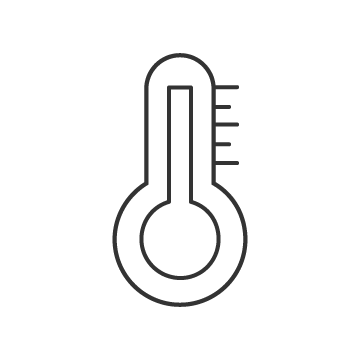Other Parts Discussed in Post: HDC3022 When designing for increased efficiency in heating, ventilation and air-conditioning (HVAC) systems, sensor accuracy and consistency have a significant effect. A system’s ability to accurately sense and measure temperature and humidity levels of inside and outside air sensors, damper controls, thermostats and fans minimizes system run time because the system can use more data to make better decisions. Along with proper HVAC implementation and maintenance, real-time control of HVAC system components and sensor choice can save consumers as much as 25%.
When designing HVAC systems like the one shown in Figure 1, sensor accuracy, repeatability and overall reliability are extremely important.

Figure 1: A commercial or residential HVAC system
HVAC operation and efficiency
An HVAC system includes sensors throughout the structure, located in the mixed and supply air ducts and the outside and return air ducts, as well as in the thermostat. These sensors provide the raw data from which the controller manages the system’s performance. In primitive HVAC systems, there might only be temperature sensors located in some of the positions shown in Figure 1, and they might contain the oldest technology available (negative temperature coefficient thermistors [NTCs] and resistive temperature detectors). Modern systems might include two enthalpy economizer sensors, with one located in the return air path and one in the outdoor air path. When the thermostat is adjusted or the mixed-air temperature goes above a setpoint, the air with the lower enthalpy (from the outdoor or return air) is brought into the conditioning section of the air handler. This is a method of controlling outdoor air usage. It may appear wasteful to cool outdoor air at higher temperatures than return air, but the amount of mechanical cooling required to dehumidify air often exceeds that required to lower the dry-bulb temperature.
In buildings with substantial moisture generation, potentially from a kitchen or shower, this type of control sequence can result in substantial savings compared to methods that include using a dry-bulb temperature sensor high limit alone. Using enthalpy modules is significant, as about 50% of the cooling capacity of an air-conditioning system is used to dehumidify conditioned air, removing latent heat before the sensible heat temperature begins to drop.
HVAC systems without humidity sensors will not provide the cooling necessary to dehumidify the air before it enters the building. Using a single enthalpy economizer instead of dry-bulb temperature lowers cooling costs in most climates. And while these systems are effective and provide improvement over temperature-only systems, a second combined sensor module in the system adds another measurement location for data, and thus an opportunity to increase system efficiency.

Improve system operating costs and efficiency
 |
Explore the HDC3022 integrated sensor, TMP1826 single-wire digital temperature sensor and TMP61 linear thermistor. |

Why accuracy and consistency matter
Since an HVAC system comprises thermostats and wet bulbs that contain temperature and humidity sensors reporting to a central control system, inaccurate sensors can prematurely or falsely trigger the control system if the accuracy is off. A system error as small as ±1°C or 5% relative humidity equates to noticeable additional costs or potential savings, while also affecting electromechanical equipment lifetimes.
For example, a humidity sensor with a typical relative humidity accuracy of 5% is capturing a time zero reading. Over time, given stresses on a system, such as high temperature or contamination, the sensor will drift. Understanding drift is paramount to understanding system efficiency over time, and minimizing drift can enable better performance.
Technological advancements have made it possible to integrate sensing elements with low drift and high accuracy. The HDC3022 is a factory-calibrated integrated humidity and temperature sensor with a typical relative humidity of 1.5%; a respective 0.2% relative humidity long-term drift; and a hydrophobic IP67 filter that protects against water and dust and is less susceptible to condensation than a device without a filter. These humidity sensors have an integrated temperature sensor with better than 0.4°C accuracy
Even with such high-performance sensors, you need to consider impacts to accuracy beyond the sensor. Placing printed circuit boards in an enclosure for protection will require compensation to account for differences between that enclosed environment and what the user may experience.
These same concepts apply to independent temperature measurements. A compressor discharge temperature could be 110°C and rise as high as 135°C or 140°C when malfunctioning. A typical temperature sensor with an accuracy of ±3°C to ±5°C and a long-term drift of ±5°C to ±10°C would leave 15°C of design margin for the compressor. As the compressor ages, this sensor drift limits compressor efficiency by forcing it to shut down prematurely.
A linear thermistor such as the TMP61 offers inherently low long-term drift and is capable of 150°C, at a cost similar to NTC thermistors. Its linearity enables improved accuracy with software techniques such as analog-to-digital oversampling to increase resolution and reduce the effect of noise. Its high accuracy and low long-term drift enable the compressor to reduce protection margins, allowing the system to shut down less often to prevent overheating, which leads to greater efficiency. Alternatively, for the most design simplicity, system designers may consider the TMP18x digital temperature sensor, which offers ultra-high accuracy out of the box, without the sacrifice of extra wiring due to a special mode requiring only 1-wire data communication and a ground wire.
Conclusion
When designing HVAC systems, you should consider component and circuit cost, accuracy, repeatability, low drift over time, and general reliability in order to meet design requirements. Choosing the right sensors for your HVAC implementation not only makes designs better – it can also lower energy consumption and maintenance costs dramatically when compared to older systems.
Additional Resources:





